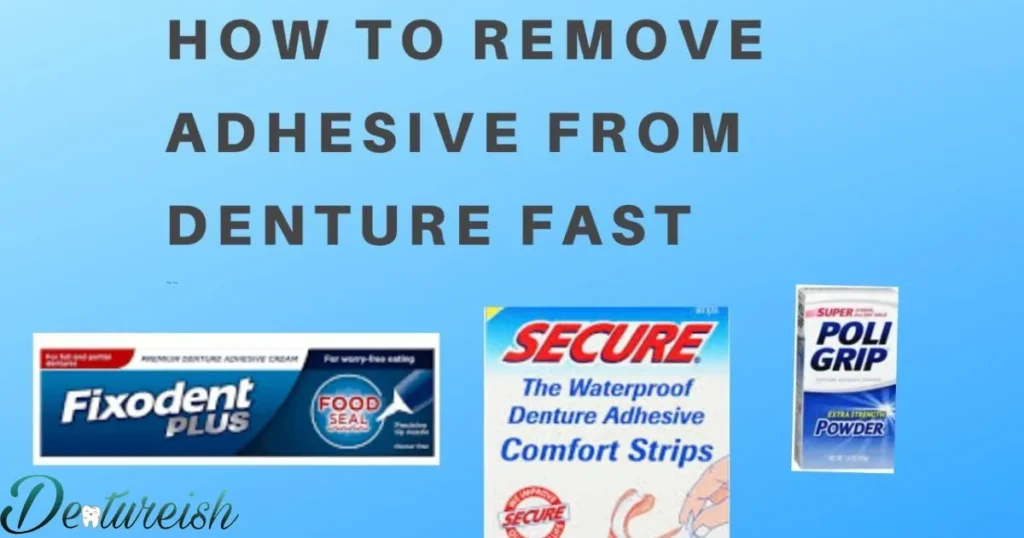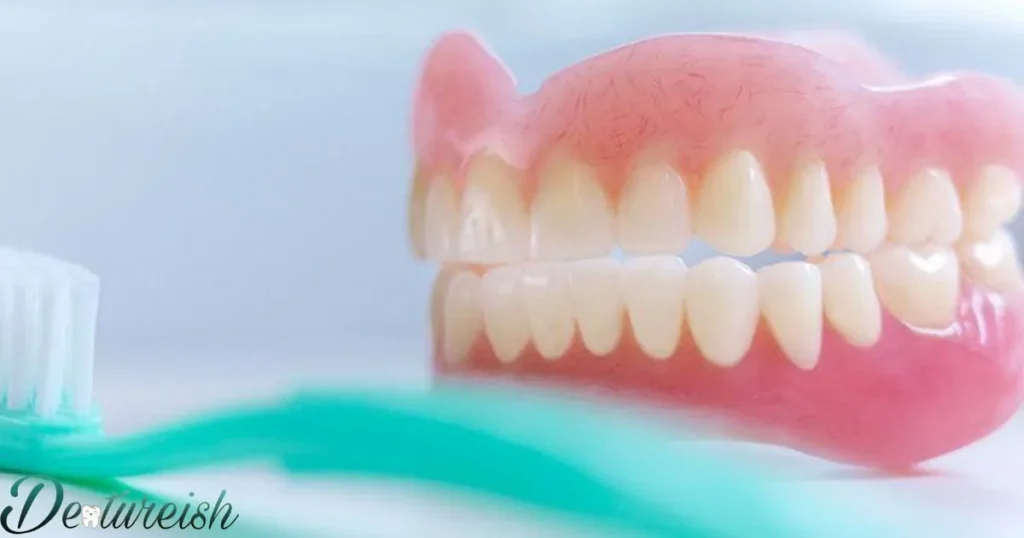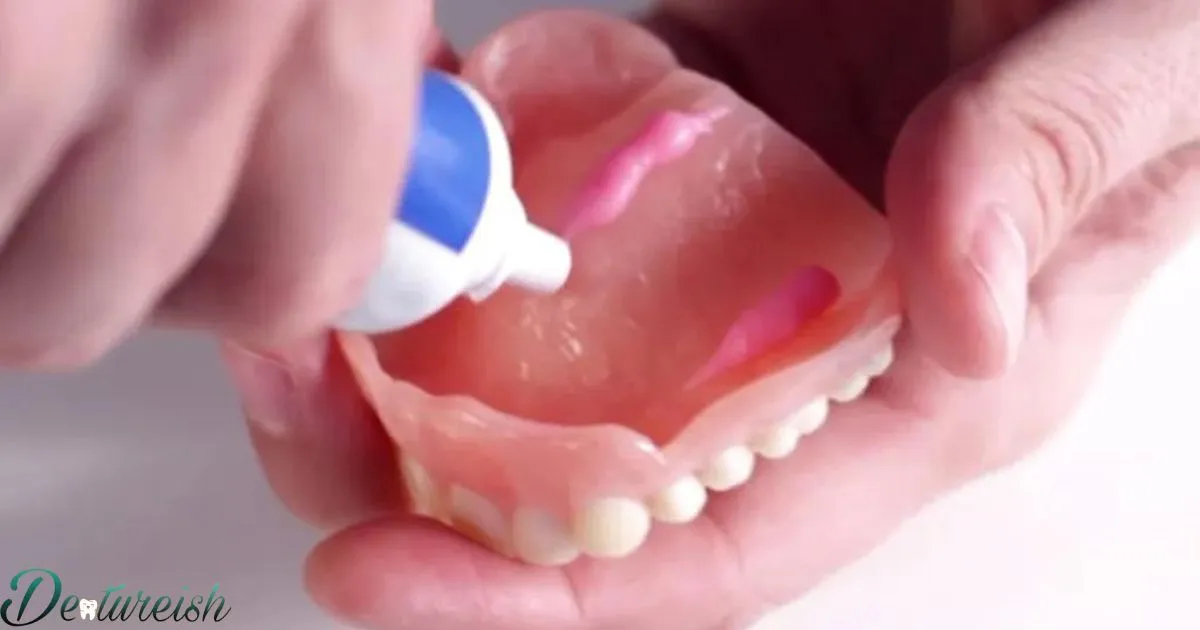Denture adhesive is used to help secure false teeth or dentures in place. Over time, excess adhesive can build up on the dentures, requiring removal to maintain good hygiene. Getting denture adhesive off dentures properly is important to avoid damaging the delicate acrylic or metal materials.
How To Get Denture Adhesive Off Dentures? Excess denture adhesive left on dentures can lead to irritation. Learning the best methods to remove it can improve denture comfort and health. Keeping dentures and gums clean prevents more serious problems down the line.
There are a few recommended techniques to get denture adhesive residue off your dentures safely. Soaking and brushing with appropriate denture cleansers dissolves adhesive. Hand soap or mild dish soap can also help break up adhesive bonds gently. Avoid hard scrubbing, hot water, or abrasive tools that could scratch the dentures.
Removing Denture Adhesive
To remove denture adhesive from dentures, use warm water and a soft-bristle toothbrush. Gently brush the dentures under running water to loosen and rinse away adhesive residue. Avoid using hot water as it can warp and damage dentures.
Best Practices
The best way to remove denture adhesive is to soak dentures in a mixture of warm water and white vinegar for 15-30 minutes. This allows the adhesive to soften for easier removal. Gently brush with a soft toothbrush afterwards. Baby shampoo can also be used instead of vinegar.
Household Solutions
Dish soap, baking soda, hydrogen peroxide and mouthwash can help break down and dissolve denture adhesive buildup. Create a paste using baking soda and water and gently scrub the dentures. Be careful not to scrub too hard on acrylic dentures as it may cause scratches. Rinse thoroughly afterwards.
Preventing Damage
It’s important to properly remove denture adhesive to prevent cracking or warping dentures over time. Adhesive left on dentures can harden like glue. Built-up adhesive under or around dentures can cause irritation and discomfort in the mouth.
Daily Care
Therefore, it is imperative for individuals with dentures to adhere to a diligent cleaning regimen to ensure optimal oral health and prevent the denture breath smell like from becoming a persistent concern.
What are some denture adhesive removal tips and tricks?
There are a few methods to help remove denture adhesive. Using warm water or mouthwash can help loosen the adhesive and rinse it away. A salt water mixture can also help dissolve adhesive residue. Gently brushing with a soft toothbrush, toothpaste, and water is effective for cleaning adhesive off gums.
Baking soda or denture cleaning powder sprinkled inside the denture can help absorb excess moisture and allow the adhesive to flake off more easily. Going slowly and carefully is key, don’t try to force or scrape the dentures as this may damage the gums.
How can I make denture adhesive easier to remove from dentures?
The key is moisture control. Allowing the adhesive to dry on the denture will make it harder to remove later on. Rinsing the dentures with warm water as soon as they are removed can prevent buildup.
Using something absorbent like a paper towel or washcloth pressed against the adhesive for a few seconds will soak up moisture and loosen the adhesive. Denture cleaning powder or baking soda can also help – sprinkle it inside the denture, let it sit briefly to absorb moisture, then rinse it out along with the adhesive. Going slowly and not letting adhesive residue build up over time is important.
How often should I remove and clean off denture adhesive?
Denture adhesive should be fully removed and cleaned at least once a day, typically before bed. The goal is to allow the gums and oral tissues a break from the adhesive for 6-8 hours per day. Removing adhesive at night gives time for the gums to “breathe” while sleeping.
Any adhesive left for longer periods increases the risk of irritation, infection, or other oral health issues. It’s also important to brush the gums and tongue after removing adhesive, to clear away any remaining residue5. Doing this daily removal and cleaning routine prevents buildup over time.
What areas of my dentures should I focus on when removing adhesive?
When removing adhesive, focus cleaning efforts on the inner surface of the denture that contacts the gums and roof of the mouth. Pay extra attention to crevices and porous areas where adhesive can collect. Use an old soft-bristle toothbrush and gently scrub to loosen residue.
Also carefully brush the gums and tongue to remove any leftover adhesive. As a final step, thoroughly rinse the outside and inside of dentures with warm water or mouthwash. Check for any last bits of adhesive and remove them. This whole-denture cleaning helps prevent irritation and maintain good oral health.
When removing denture adhesive, what should I avoid doing?
Avoid using excessive force, hard scrubbing, or scraping tools which could damage the delicate gum tissue or dentures1. Don’t try to forcefully click dentures in and out to loosen adhesive, as the pressure could crack the dentures.
Avoid letting adhesive residue build up over consecutive days of wear, since removing heavy buildup is more difficult. Don’t simply reapply new adhesive on top of old – the layers of old adhesive need to be cleaned off first. And importantly, don’t use solutions that could discolor or corrode the denture material itself while trying to remove adhesive. Harsh chemicals or cleaners may damage dentures.
How to remove 3 types of denture adhesive from dentures

The 3 main types of denture adhesive are paste, powder, and cushion grip. Each has a different composition and requires a specific method for removal. Generally, soaking dentures in warm water or using a soft brush and toothpaste works for all types. Mouthwash and salt water rinses also help break down residue.
How to remove paste denture adhesive from dentures
5 easy short tips for how to remove paste denture adhesive from dentures:
- Soak dentures in warm water to loosen adhesive residue.
- Use a soft-bristled toothbrush and gently scrub to help remove adhesive.
- Try using denture cleaner tablets or solution to dissolve adhesive paste.
- Rinse dentures with mouthwash to help break down adhesive bonds.
- For stubborn paste residue, lay dentures on a dry towel to draw out moisture and adhesive.
How to remove powder denture adhesive from dentures
For powder adhesives, soaking dentures in warm water allows particles to rise to the surface for removal. An exfoliating glove rubbed on dentures under running water lifts powder residue. Rinsing with mouthwash or a salt solution removes any remaining powder.
How to remove cushion grip denture adhesive from dentures
Cushion grip adhesive pads can be rubbed off under running water using an exfoliating glove or soft brush. Soaking in warm water also allows the pads to dissolve for removal. Mouthwash and saltwater rinses clear residue from gums and dentures.
The methods differ mainly in the use of exfoliating gloves, electric toothbrushes, and soaking which target the specific composition of each adhesive type for removal. But warm water, mouthwash and salt rinses work for all kinds.
Why does denture adhesive stick so stubbornly to dentures?
Denture adhesive is designed to create a strong bond between the denture and the gums in order to hold the denture firmly in place. The adhesive is made of materials that adhere very well to the acrylic and metal materials that dentures are constructed from.
As the adhesive interacts with moisture and saliva in the mouth, it tends to take on a more gum-like sticky consistency that resists easy removal. This combination of chemical bonding properties and moisture-activated stickiness makes denture adhesive cling stubbornly to dentures after use.
What properties of denture adhesive cause it to adhere to dentures?
Denture adhesive sticks to dentures because of polymers. The polymers bond to the denture surface. Denture adhesive also has plasticizers. They allow the adhesive to go into tiny holes in the denture.
This helps it stick better. Denture adhesive has natural gums too. These swell up and get sticky when wet. Oils in the adhesive also make it tacky. All these things help denture adhesive grab onto the denture tightly.
Here is a table summarizing the properties that cause denture adhesive to adhere to dentures:
| Properties that Cause Denture Adhesive to Adhere to Dentures |
| Polymers that bond to the denture surface |
| Plasticizers that penetrate microscopic pores |
| Natural gums that swell and get sticky when wet |
| Oils that create a tacky surface |
How does the oral environment impact denture adhesive residue?
The warm, moist environment of the mouth causes denture adhesive to soften and become more viscous and sticky. Ingredients in the adhesive absorb moisture, swell up, and take on a gum-like texture.
Saliva also starts to break down the adhesive polymers through hydrolysis while oral bacteria produce enzymes that further degrade the adhesive. However, the adhesive is formulated to maintain adhesive properties for many hours despite the oral conditions. This balance of degradation and persistence is what makes adhesive residue stubborn.
Why is saliva alone often ineffective at removing denture adhesive?
Although saliva helps break down denture adhesive over time, saliva by itself is relatively ineffective for rapid removal of adhesive residue. Saliva cannot quickly penetrate and dissolve the existing adhesive bonds nor can it rapidly flush away the viscous adhesive.
Ingredients in denture adhesive are designed to resist the solubilizing effects of saliva in order to prolong adhesive properties. So while saliva slowly degrades adhesive, its effects are too gradual and mild to enable easy adhesive removal through rinsing alone.
How can I prevent excessive denture adhesive buildup?
Using the minimal effective amount of adhesive needed can help reduce buildup. Additionally, soaking dentures in cleansing solutions instead of just water can help dissolve adhesive residue. S
oft toothbrushes, microfiber cloths, and denture-cleaning pastes can also mechanically remove residue. Monitoring ill-fitting dentures and getting adjustments or remakes done promptly can further reduce reliance on excessive adhesive. Lastly, giving gums and dentures an adhesive-free break overnight allows saliva to slowly dissolve residual adhesive.
What denture cleaning regimen removes adhesive effectively?

An effective denture cleaning regimen to remove adhesive involves soaking dentures in warm water while scrubbing with a soft-bristled toothbrush and small amount of toothpaste. This loosens adhesive so it can be rinsed away. Repeating this 3-4 times ensures thorough removal from denture surfaces and oral tissues. Using an electric toothbrush can also help remove adhesive residue.
Should I use denture cleaner tablets, paste, or liquid cleansers?
Denture cleanser tablets, paste or liquid cleansers that are not too harsh or abrasive can be used as part of denture care to help remove food, plaque and bacteria. However warm water, a soft toothbrush, toothpaste and an electric toothbrush are typically the most effective methods for removing denture adhesive itself.
What brush type is most effective at removing denture adhesive?
A soft-bristled toothbrush is recommended for gently scrubbing denture surfaces and oral tissues to remove adhesive residue without damaging dentures. Soft bristles allow thorough cleaning without being too abrasive.
How often should I do a deep clean to remove denture adhesive residue?
It’s advisable to do a deep clean by removing dentures and thoroughly scrubbing away all adhesive residue at least once a day, typically before bed. This helps prevent buildup and maintains cleanliness.
When should I take my dentures to a professional denture cleaner?
If unable to fully remove adhesive residue at home even after multiple thorough cleaning attempts, dentures should be taken to a professional denture cleaner for a deeper cleaning. Ill-fitting dentures that rely heavily on adhesive should also be assessed by a professional.
Frequently Asked Question
What is the easiest way to remove denture adhesive?
The easiest way to remove denture adhesive is by soaking dentures in warm water to soften the adhesive before gently prying them loose.
Should I use rubbing alcohol to get adhesive off my dentures?
Avoid using rubbing alcohol to remove denture adhesive, as it can damage acrylic dentures.
What household products help get stubborn denture adhesive off?
Baking soda, white vinegar, or denture cleaning tablets help get stubborn denture adhesive residue off.
How can I prevent excessive denture adhesive buildup?
Rinse dentures after every meal to help prevent excessive adhesive buildup that is harder to remove.
Why is properly removing denture adhesive important?
Properly removing denture adhesive prevents irritation and infection in the mouth and keeps dentures fitting comfortably.
Conclusion
Removing denture adhesive thoroughly is important for oral health. Start by swishing warm water to loosen the adhesive. Then use a soft brush and toothpaste to gently scrub the dentures and mouth. Soak dentures in a store-bought cleanser or diluted vinegar to fully dissolve residue. Finish by rinsing the mouth and dentures until free of adhesive.
Getting all traces of denture adhesive off requires patience and gentle persistence. Loosening with warm water first makes scrubbing easier. Always use soft brushes and non-abrasive cleaners. Completely removing the adhesive prevents irritation and maintains denture fit and oral health. Establish a daily routine for thorough adhesive removal and cleaning.

